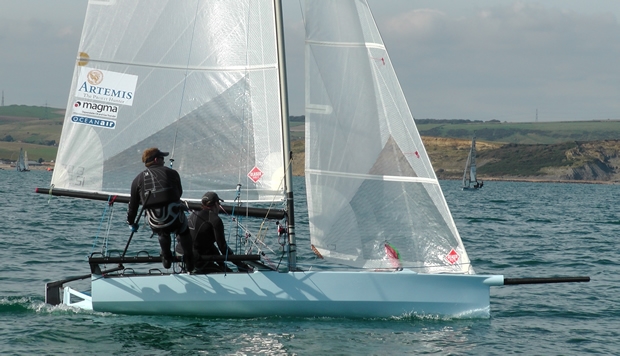
The first Bieker 6
One of the most highly anticipated boats taking part in last week’s Artemis International 14 World Championship was the latest offering from design guru Paul Bieker. The last 14 design from Seattle-based Bieker, who has also been part of Oracle Racing’s design team, was the Bieker 5. These won the world championships in 2005 with Howie Hamlin and Euan McNicol and subsequently in 2008 and 2010 with Archie Massey. But in Weymouth last week was the first example of the new Beiker 6. This was being sailed by Kris Henderson, who builds the boat in Seattle, with Joe Bersch out on the wire, who is the money.
So what is different about the 6? Like most contempory 14s, the B6’s hull is minimum beam with a substantial chine, a bowsprit and a gantry off the transom to hold the T-foil rudder. Between the 5 and 6 one of the most significant differences is at the bottom of the stem, where the shape is slightly bulbous but narrows higher up. According to Henderson this came about through Beiker’s work on the USA 17 33rd America’s Cup winning trimaran where the floats had a wavepiercing-type bow. “The waterline is a lot narrower up in the front, so the B5 is more like a pumpkin seed-shaped waterline whereas the B6 is more of a wedge waterline.”
So the waterline shape is wider aft providing the crew with more stability when gybing and due to the fullness and because of the added buoyancy up forward this enables the rudder T-foil to be used more. “Even in medium to light breeze we’ll get the foil on really hard to get that knuckle down below the water,” says Henderson.
“The Beiker 5, or any 14, as you are going upwind in waves, it will want to auger in in the troughs and you can feel that on the helm and it slows the boat down, the apparent wind comes aft, the boat heels for a second and then you have to hike it back down again, whereas this thing literally goes right through the waves. It is very wet and the waves splash right on by but you don’t feel it on the helm at all. It knifes right through the water.”
An aim of the new boat is to make it slightly more cost effective while making it no slower than the Bieker 5. Henderson and Bersch believe the 6 achieves this. “There are a lot of high end prepreg, exotic boats that end up costing US$50,000,” says Henderson. These includes some of the Bieker 5s, which were built in prepreg carbon/Nomex in an autoclave. Instead, with the Bieker 6, they are building in wet laminate epoxy and carbon with a Divinicell foam core. “It is not a super hitech construction, but the way the hull is designed and the design of the struts that hold rig tension, she is a really hi-tech boat. They are still very stiff, but we decided it doesn’t have to be that exotic.”
There has been much interest in a bare boat without rigging or fittings and this costs US$ 18,000, while fully rigged with the mast, but no sails or foils is US$ 28,500 and the Bieker 6 complete is US$ 33-34,000. To date they have finished building three, the first boats all going to buyers on the west coast of the States.
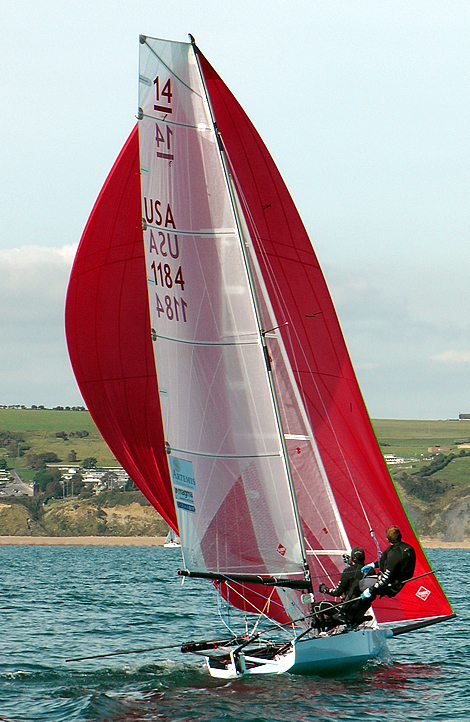
Their rudder is a Larry Tuttle WaterRat. The lifting foil isn’t the maximum size (there is a rule limiting the maximum size of the lifting foil) as apparently Bieker believes that the foil shouldn’t extend laterally beyond the chine. The rudder and its lifting foil can be inclined fore and aft by around 10 degrees. The idea is that upwind you wind on the foil to get the bow down, and this allows the crew to shuffle aft.
“You end up riding on the back of the boat which is lifting up and it lifts the bow out and you are skimming across the water which makes the water think that the boat is lighter and it flattens the stern wake out. It is tricking the water into thinking it is a longer boat,” explains Henderson. “Then you get to the top mark and you wind it off and the bow comes up, you set the big kite and then you are able to control the angle going downwind.” The foil can be used downwind get the bow over waves. It is controlled by via a twist grip on the tillers.
To see the video in its full screen glory, click on the bottom RH button in the viewer.
The centreboard is from Russell Brown to a Bieker design and can be gybed - articulating by +/- 4 degrees - to help eliminate leeway. This is by no means a new feature in the International 14 class, first tried back in the early 1980s. According to Henderson they only use it upwind, in pretty much all but the most blustery conditions. The gybing mechanism has some interesting features such as a locking device attached to the spinnaker tack line, so that whenever the kite is hoisted the board automatically centres itself. Controls for the locking mechanism is also led out to the rail. The reason for this is that at the Worlds they have reaching leg so there are times when they want the board locked centrally when they don’t have the kite hoisted.
Another new feature of the Bieker 6 is her mast, which is fitted with one set of spreaders instead of two. The mast is a Bieker design, built by ICE in Hood River, Oregon using a high modulus carbon fibre tube. The diameter of the spar looks bigger but in fact it is the same as most other masts in the 14 fleet, only that it tapers less higher up. “It is a very straight mast, really stiff with hardly any luff curve cut into the mainsail,” says Henderson. Thus the shrouds are a metre higher than they might normally be on a twin spreader rig and this in turn allows a higher aspect jib to be used. The end result is less windage. Another development is due to the narrowness of the hull, the shrouds are now attached to the racks.
“This is our first regatta with this rig," says Henderson. "So we are learning a lot from sailing with this set-up. Right now, people have been interested in buying just the hull because not everyone understands this rig yet. Once it sails a bit more, people will come around and say this makes sense.”
So while the skiff world is known for using masts with whippy tops, there now seems to be a move back to stiffer, more powerful rigs.
The mainsail has a halyard lock on it which was causing the duo a few problems at the Worlds. “It wouldn’t work without that because of the amount of loads that we’re sailing with,” says Henderson. “The sail is designed with vertical straps in it, just like a catamaran or a windsurfer, so you can pull on that thing so hard that it just goes completely flat up top.” The sails have been made by Jay Glaser.
Henderson and Bersch typically sail with the ends of the main and jib sheets tied together, so that they are easier to locate. The jib sheet is on a 360degree swivel so that when they come out of a gybe it automatically untangles.
So how is it performing? The Bieker 6 ended up 12th at the Worlds, although this is not a fair reflection of her potential. “She is very fast off the wind - it may be the fullness in the bow that allows you to push on it, lower and faster that we’ve noticed,” says Henderson. “Then in certain conditions, particularly in the 12 knot range, the rig seemed really really powerful - I don’t know if that is the gybing centreboard or the hull shape or the rig – we have so many variables going on.”
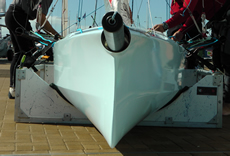 |
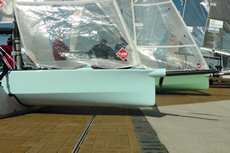 |
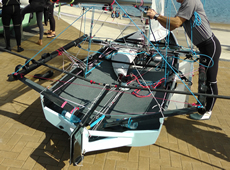 |
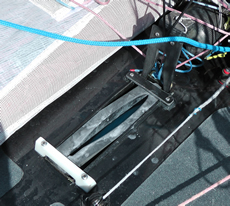 |
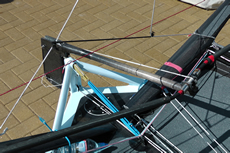 |
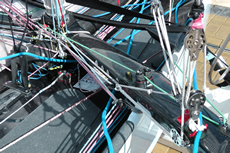 |
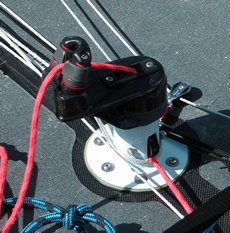 |
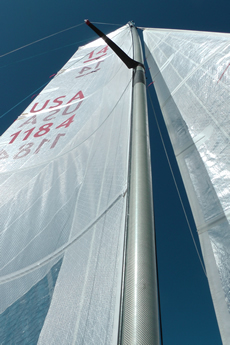 |
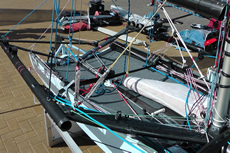 |
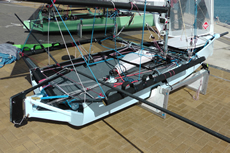 |

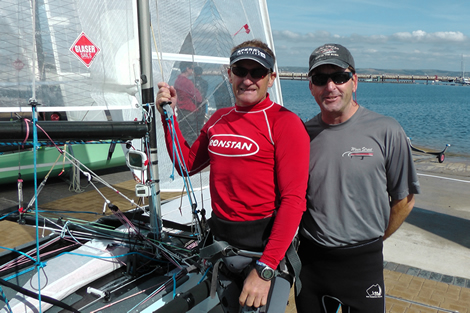









Latest Comments
Add a comment - Members log in